【報告記録】The transgender history of Japan [論文・講演アーカイブ]
2014年2月14日から18日まで、タイ・バンコクで「WPATH 2014 Symposium in Bangkok」が開催されました。
「WPATH 2014」は「World Professional Association for Transgender Health(WPATHトランスジェンダーの健康のための世界専門職協会)」の2年に1度の世界大会で、23回目の今回は初めて欧米圏以外、アジア地域での開催となり、世界各地から520名の参加者がありました。
今回の「WPATH 2014」の大きな特色は、UNDP(国際連合開発計画)、UNAIDS(国際連合エイズ合同計画)、WHO(世界保健機関)、UNWOMAN(ジェンダー平等と女性のエンパワーメントのための国連機関)の支援でスペシャルセッション・シリーズ(連続シンポジウム)「Trans People in Asia and the Pacific」が開催されたことです。
私は15日の午後に行われた「SESSION 1: Cultural, legal and social environments」で、日本のトランスジェンダーの歴史と現在について報告しました。
持ち時間10分(厳守)ということで、不十分な点も多いのですが、以下は、その内容です。
なお、報告は日本語で行い、英語への翻訳は東優子さん(大阪府立大学教授)にお願いしました。
----------------------------------------------------------------------
「WPATH(トランスジェンダーの健康のための世界専門職協会)2014 Symposium in Bangkok」
「Asian and Pacific trans community leaders working in health and rights-SESSION 1: Cultural, legal and social environments」
(1) The transgender history of Japan
JUNKO MITSUHASHI (JAPAN)
.jpg)
(口頭説明)皆さん、こんにちは。三橋順子です。私はいくつかの大学で講義をしながら、日本のトランスジェンダー歴史について研究しています。
Hello, everyone. My name is Junko Mitsuhashi. I am a lecturer at several different universities and studying Transgender history in Japan.
-----------------------------------------------
(2)Before 712
.jpg)
YAMATO TAKERU(The hero of the founding of the country)
(口頭説明) 日本は、女装の建国英雄をもつ国です。
Japan is a country whose founding hero was a cross-dressed man.
-----------------------------------------------
(3)1764
-db60c.jpg)
(CENTER)SEGAWA KIKUNOZYO(Ⅱ)
Three beauties of Edo(Tokyo) by SUZUKI HARUNOBU
(口頭説明)鈴木春信の「江戸三美人図」で、両サイドに生得的な女性を従えて、中央に立つのは女装の俳優です。
This is a famous painting titled “Three beauties of Edo” by Harunobu Suzuki. The person in the center is an actor who is cross-dressed with two natal females on either side.
-----------------------------------------------
(4)1870s
-db134.jpg)
-c0de3.jpg)
The beginning of oppression 抑圧の始まり
(口頭説明)欧米の文明が入ってくると、異性装者への抑圧が始まりました。
左は女装で生活していて逮捕された男性、右は男性であることがわかり髪を切られた「妻」です。
Oppression against cross-dressers began with the introduction of Western influences. The image on the left is an article reporting a Trans woman being arrested by the police and the image on the right is a report about a wife whose husband cut her hair short after finding out that she was a he.
-----------------------------------------------
(5)1930s
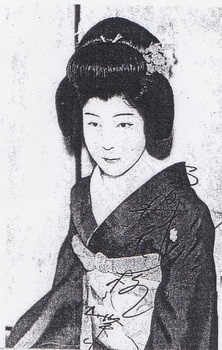
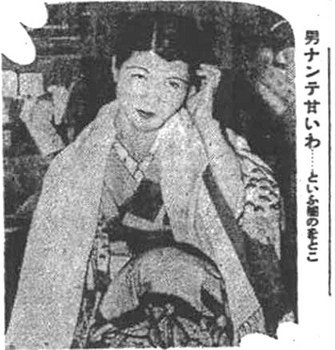
(キャプション)(左)SOGANOYA MOMOCHO(ACTOR)
(右)FUKUSIMA YUMIKO(SEX WORKER)
(口頭説明)20世紀の前半、トランスジェンダーの生きる道は、女装の俳優かセックスワーカーだけでした。
桃蝶は女性雑誌の表紙モデルになり、ゆみ子は非合法売春の女性と思われ逮捕されました。
In the first half of the 20th century, the only way for transgender people to survive was either to live as a cross-gender actor or as a sexworker. Momocho Soganoya, on the left, made the cover of a women’s magazine. Yumiko Fukushima, on the right, got arrested for conducting illegal prostitution
-----------------------------------------------
(6)1935
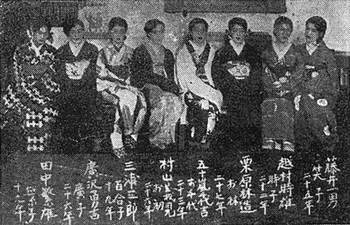
(キャプション)transgender sexworkers
(口頭説明)1935年頃、大阪の女装男娼の集会の記念写真。
女名前、男性としての本名、そして年齢が記されている。
-----------------------------------------------
(7)1946~1959
.jpg)
SEX WORKER上野の女装男娼
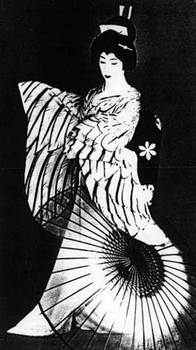
GEISYA女装芸者(伊東温泉チャコ)
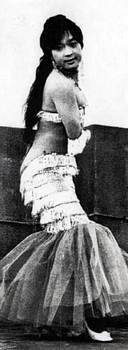
DANCER銀座ローズ
(口頭説明)第二次世界大戦が終わり、日本の旧秩序が崩れると、トランスジェンダーたちが再び社会の表面に出てきます。
After WWII, the Japanese old order collapsed and transgender people became more socially visible once again, and appeared on the surface of society.
-----------------------------------------------
(8)1951 The first SRS in Japan
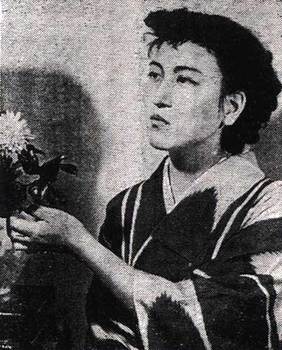
(キャプション)NAGAI AKIKO(SINGER 1924~?)
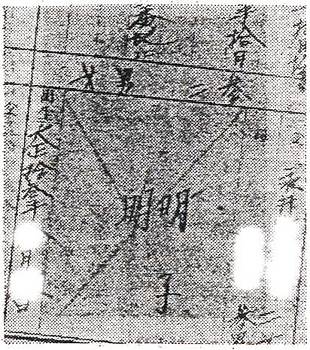
(キャプション)Akiko’s “koseki” (family registry)
(口頭説明)日本最初のSRSは1951年に行われました。
これはクリスチーナ・ジョルゲンセンの手術とほぼ同じ時期です。
明子は、戸籍の性別も男性から女性に変更しました。
The very first recorded SRS was conducted in 1951. This is around the same time or even a bit earlier than when the world famous Christine Jorgensen had received SRS in Denmark. Akiko successfully changed gender from male to female on her “koseki” which is the Japanese family registry.
-----------------------------------------------
(9)1960s~1970s
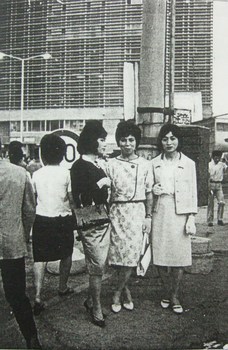
新宿駅前の女装者(1964) Cross-dressers in front of Shinjuku Station
-bf5db.jpg)
女装者と女装者好きの男性が集まるバーができた(1969) Bar for trans* and tranny-chasers (1969)
-075f4.jpg)
女装者と男性の結婚式(1971) Wedding photo with a man (1971)
-----------------------------------------------
(10)1980s~1990s
.jpg)
DANCER
-e3237.jpg) 「HOSTESS」
「HOSTESS」
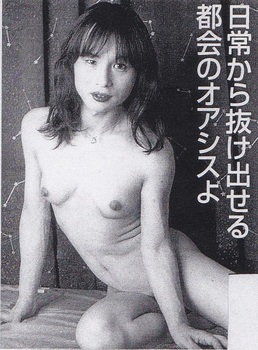
SEX WORKER
(口頭説明)しかし、20世紀の末になっても、トランスジェンダーの職業は、ショービジネス、飲食接客業、セックスワーカーの3つに限定されていました。
それ以外の職業に就くことはとても難しい状況が続いていました。
But I must emphasize that even at the end of the 20th century, occupational options for Transgender people were limited to three domains: working in show business, as a hostess, or as a sexworker. It continued to be difficult to get a job and be professional in other areas of Japanese society.
-----------------------------------------------
(11)2000
.jpg)
.jpg)
A “cross-dressed” lecturer at Chuo University
(口頭説明)ですから、初めてトランスジェンダーが大学教員になった時の社会的反応はとても大いものがありました。
最初の講義日に3つの週刊誌が取材に来て、その後もテレビ・ニュースなどで紹介されました。
So, when I became a lecturer at a private university, the very first Transgender lecturer in Japanese history, there was a large impact on society. On my first day, three magazines came to take photos and get interviews, and it was discussed in the media even later on.
-----------------------------------------------
(12)2010s

HARUNA AI(1972~)

SATO KAYO(1988~)
(口頭説明)現在の日本には、テレビで活躍し、大企業のコマーシャルに起用されるトランスジェンダーもいます。
Currently in Japan, there are transgender people who have gained popularity on TV and make appearances in commercials for large companies.
-----------------------------------------------
メッセージ
以上、日本のトランスジェンダーの歴史を駆け足でたどりました。
日本の前近代では、トランスジェンダーは、特定の職能をもって社会の構成員としての役割を果たしていました。
Transgender people in the pre-modern era, took roles with particular professional skills and functioned as members of society.
その職能は宗教的職能(シャーマン)がベースでした。
The basis of this work was as a kind of shaman.
日本の宗教には、異性装を否定する規範はなく、したがって、強い社会的抑圧はありませんでした。
In terms of religions, there were no norms that denied transgender people; thus, there was no strong social oppression.
宗教的職能(シャーマン)から芸能的職能、飲食接客的職能、性サービス的職能、男女の仲介者的職能が派生しました。
The role as a kind of shaman expanded to the entertainment business, service industry (e.g., a hostess in a bar), sex service, and match-making for men and women
抑圧が強まったのは、西欧文明が流入した1870年代以降のことです。
Strong social oppression occurred and continued from 1870’s as western influences came.
.現在の日本では、法律が定めた要件を満たせば戸籍の性別を変更することができ、性別を変更したトランスジェンダーは、MtFなら生得的な女性、FtMなら生得的な男性と同じに扱われることになっています。
Today, if the five conditions regulated by GID Law (established in 2003) are met, transgender people can change their gender on their “koseki” (Family Registry).
After changing their gender, Transmen and transwomen can be treated the same as natal male and female citizens respectively.
これは、1990年代末以降のGID医療の導入と2004年の法整備の成果です。
This rather drastic change occurred in the mid-1990’s when GID medicine was introduced and in 2004 when the GID law was enacted.
法律が定める要件に問題はあるものの、少なくとも法システム的には状況は大きく改善されました。
Although the five conditions forced on Transgender people by the law are somewhat problematic, I can say at least in terms of the legal system, the situation has been greatly improved.
しかし、GIDの診断を受けていなかったり、戸籍の性別を変更していないトランスジェンダーは、いまだに就労が困難な状態が続いています。
However, it continues to be difficult to get a job for Transgender people who have not been diagnosed with GID and/or have not changed their gender on their “koseki”.
これは、トランスジェンダーをめぐる社会状況の改善が、GIDという精神疾患をもつ人たちの医療福祉として行われ、性的マイノリティの人権という観点ではなされなかったためです。
This is due to the fact that recent social changes occurred in terms of improving medical and welfare situations of people with a “psychiatric” condition (GID), but not in the light of the human rights of a sexual minority.
今後、性別移行の脱医療化の流れの中で、日本においても、性的マイノリティの人権という観点から、就労問題の改善など、積極的な施策が取られるべきです。
As the de-pathologization of Trans* progresses, I hope, more active measures will be taken to improve our work situations in the light of human rights.
トランスジェンダーが、自らの意志で自由に職業を選択し、その能力を生かして社会に貢献できる社会を目指して、今後も教育と研究という私の仕事を続けていこうと思います。
I will continue my work as an educator and researcher, which I hope contributes to positive changes in our society so that Transgender people have occupational options, freely choose professions, and make contributions as members of society.
ご清聴ありがとうございました。
「WPATH 2014」は「World Professional Association for Transgender Health(WPATHトランスジェンダーの健康のための世界専門職協会)」の2年に1度の世界大会で、23回目の今回は初めて欧米圏以外、アジア地域での開催となり、世界各地から520名の参加者がありました。
今回の「WPATH 2014」の大きな特色は、UNDP(国際連合開発計画)、UNAIDS(国際連合エイズ合同計画)、WHO(世界保健機関)、UNWOMAN(ジェンダー平等と女性のエンパワーメントのための国連機関)の支援でスペシャルセッション・シリーズ(連続シンポジウム)「Trans People in Asia and the Pacific」が開催されたことです。
私は15日の午後に行われた「SESSION 1: Cultural, legal and social environments」で、日本のトランスジェンダーの歴史と現在について報告しました。
持ち時間10分(厳守)ということで、不十分な点も多いのですが、以下は、その内容です。
なお、報告は日本語で行い、英語への翻訳は東優子さん(大阪府立大学教授)にお願いしました。
----------------------------------------------------------------------
「WPATH(トランスジェンダーの健康のための世界専門職協会)2014 Symposium in Bangkok」
「Asian and Pacific trans community leaders working in health and rights-SESSION 1: Cultural, legal and social environments」
(1) The transgender history of Japan
JUNKO MITSUHASHI (JAPAN)
.jpg)
(口頭説明)皆さん、こんにちは。三橋順子です。私はいくつかの大学で講義をしながら、日本のトランスジェンダー歴史について研究しています。
Hello, everyone. My name is Junko Mitsuhashi. I am a lecturer at several different universities and studying Transgender history in Japan.
-----------------------------------------------
(2)Before 712
.jpg)
YAMATO TAKERU(The hero of the founding of the country)
(口頭説明) 日本は、女装の建国英雄をもつ国です。
Japan is a country whose founding hero was a cross-dressed man.
-----------------------------------------------
(3)1764
-db60c.jpg)
(CENTER)SEGAWA KIKUNOZYO(Ⅱ)
Three beauties of Edo(Tokyo) by SUZUKI HARUNOBU
(口頭説明)鈴木春信の「江戸三美人図」で、両サイドに生得的な女性を従えて、中央に立つのは女装の俳優です。
This is a famous painting titled “Three beauties of Edo” by Harunobu Suzuki. The person in the center is an actor who is cross-dressed with two natal females on either side.
-----------------------------------------------
(4)1870s
-db134.jpg)
-c0de3.jpg)
The beginning of oppression 抑圧の始まり
(口頭説明)欧米の文明が入ってくると、異性装者への抑圧が始まりました。
左は女装で生活していて逮捕された男性、右は男性であることがわかり髪を切られた「妻」です。
Oppression against cross-dressers began with the introduction of Western influences. The image on the left is an article reporting a Trans woman being arrested by the police and the image on the right is a report about a wife whose husband cut her hair short after finding out that she was a he.
-----------------------------------------------
(5)1930s


(キャプション)(左)SOGANOYA MOMOCHO(ACTOR)
(右)FUKUSIMA YUMIKO(SEX WORKER)
(口頭説明)20世紀の前半、トランスジェンダーの生きる道は、女装の俳優かセックスワーカーだけでした。
桃蝶は女性雑誌の表紙モデルになり、ゆみ子は非合法売春の女性と思われ逮捕されました。
In the first half of the 20th century, the only way for transgender people to survive was either to live as a cross-gender actor or as a sexworker. Momocho Soganoya, on the left, made the cover of a women’s magazine. Yumiko Fukushima, on the right, got arrested for conducting illegal prostitution
-----------------------------------------------
(6)1935

(キャプション)transgender sexworkers
(口頭説明)1935年頃、大阪の女装男娼の集会の記念写真。
女名前、男性としての本名、そして年齢が記されている。
-----------------------------------------------
(7)1946~1959
.jpg)
SEX WORKER上野の女装男娼

GEISYA女装芸者(伊東温泉チャコ)

DANCER銀座ローズ
(口頭説明)第二次世界大戦が終わり、日本の旧秩序が崩れると、トランスジェンダーたちが再び社会の表面に出てきます。
After WWII, the Japanese old order collapsed and transgender people became more socially visible once again, and appeared on the surface of society.
-----------------------------------------------
(8)1951 The first SRS in Japan

(キャプション)NAGAI AKIKO(SINGER 1924~?)

(キャプション)Akiko’s “koseki” (family registry)
(口頭説明)日本最初のSRSは1951年に行われました。
これはクリスチーナ・ジョルゲンセンの手術とほぼ同じ時期です。
明子は、戸籍の性別も男性から女性に変更しました。
The very first recorded SRS was conducted in 1951. This is around the same time or even a bit earlier than when the world famous Christine Jorgensen had received SRS in Denmark. Akiko successfully changed gender from male to female on her “koseki” which is the Japanese family registry.
-----------------------------------------------
(9)1960s~1970s

新宿駅前の女装者(1964) Cross-dressers in front of Shinjuku Station
-bf5db.jpg)
女装者と女装者好きの男性が集まるバーができた(1969) Bar for trans* and tranny-chasers (1969)
-075f4.jpg)
女装者と男性の結婚式(1971) Wedding photo with a man (1971)
-----------------------------------------------
(10)1980s~1990s
.jpg)
DANCER
-e3237.jpg) 「HOSTESS」
「HOSTESS」

SEX WORKER
(口頭説明)しかし、20世紀の末になっても、トランスジェンダーの職業は、ショービジネス、飲食接客業、セックスワーカーの3つに限定されていました。
それ以外の職業に就くことはとても難しい状況が続いていました。
But I must emphasize that even at the end of the 20th century, occupational options for Transgender people were limited to three domains: working in show business, as a hostess, or as a sexworker. It continued to be difficult to get a job and be professional in other areas of Japanese society.
-----------------------------------------------
(11)2000
.jpg)
.jpg)
A “cross-dressed” lecturer at Chuo University
(口頭説明)ですから、初めてトランスジェンダーが大学教員になった時の社会的反応はとても大いものがありました。
最初の講義日に3つの週刊誌が取材に来て、その後もテレビ・ニュースなどで紹介されました。
So, when I became a lecturer at a private university, the very first Transgender lecturer in Japanese history, there was a large impact on society. On my first day, three magazines came to take photos and get interviews, and it was discussed in the media even later on.
-----------------------------------------------
(12)2010s

HARUNA AI(1972~)

SATO KAYO(1988~)
(口頭説明)現在の日本には、テレビで活躍し、大企業のコマーシャルに起用されるトランスジェンダーもいます。
Currently in Japan, there are transgender people who have gained popularity on TV and make appearances in commercials for large companies.
-----------------------------------------------
メッセージ
以上、日本のトランスジェンダーの歴史を駆け足でたどりました。
日本の前近代では、トランスジェンダーは、特定の職能をもって社会の構成員としての役割を果たしていました。
Transgender people in the pre-modern era, took roles with particular professional skills and functioned as members of society.
その職能は宗教的職能(シャーマン)がベースでした。
The basis of this work was as a kind of shaman.
日本の宗教には、異性装を否定する規範はなく、したがって、強い社会的抑圧はありませんでした。
In terms of religions, there were no norms that denied transgender people; thus, there was no strong social oppression.
宗教的職能(シャーマン)から芸能的職能、飲食接客的職能、性サービス的職能、男女の仲介者的職能が派生しました。
The role as a kind of shaman expanded to the entertainment business, service industry (e.g., a hostess in a bar), sex service, and match-making for men and women
抑圧が強まったのは、西欧文明が流入した1870年代以降のことです。
Strong social oppression occurred and continued from 1870’s as western influences came.
.現在の日本では、法律が定めた要件を満たせば戸籍の性別を変更することができ、性別を変更したトランスジェンダーは、MtFなら生得的な女性、FtMなら生得的な男性と同じに扱われることになっています。
Today, if the five conditions regulated by GID Law (established in 2003) are met, transgender people can change their gender on their “koseki” (Family Registry).
After changing their gender, Transmen and transwomen can be treated the same as natal male and female citizens respectively.
これは、1990年代末以降のGID医療の導入と2004年の法整備の成果です。
This rather drastic change occurred in the mid-1990’s when GID medicine was introduced and in 2004 when the GID law was enacted.
法律が定める要件に問題はあるものの、少なくとも法システム的には状況は大きく改善されました。
Although the five conditions forced on Transgender people by the law are somewhat problematic, I can say at least in terms of the legal system, the situation has been greatly improved.
しかし、GIDの診断を受けていなかったり、戸籍の性別を変更していないトランスジェンダーは、いまだに就労が困難な状態が続いています。
However, it continues to be difficult to get a job for Transgender people who have not been diagnosed with GID and/or have not changed their gender on their “koseki”.
これは、トランスジェンダーをめぐる社会状況の改善が、GIDという精神疾患をもつ人たちの医療福祉として行われ、性的マイノリティの人権という観点ではなされなかったためです。
This is due to the fact that recent social changes occurred in terms of improving medical and welfare situations of people with a “psychiatric” condition (GID), but not in the light of the human rights of a sexual minority.
今後、性別移行の脱医療化の流れの中で、日本においても、性的マイノリティの人権という観点から、就労問題の改善など、積極的な施策が取られるべきです。
As the de-pathologization of Trans* progresses, I hope, more active measures will be taken to improve our work situations in the light of human rights.
トランスジェンダーが、自らの意志で自由に職業を選択し、その能力を生かして社会に貢献できる社会を目指して、今後も教育と研究という私の仕事を続けていこうと思います。
I will continue my work as an educator and researcher, which I hope contributes to positive changes in our society so that Transgender people have occupational options, freely choose professions, and make contributions as members of society.
ご清聴ありがとうございました。



